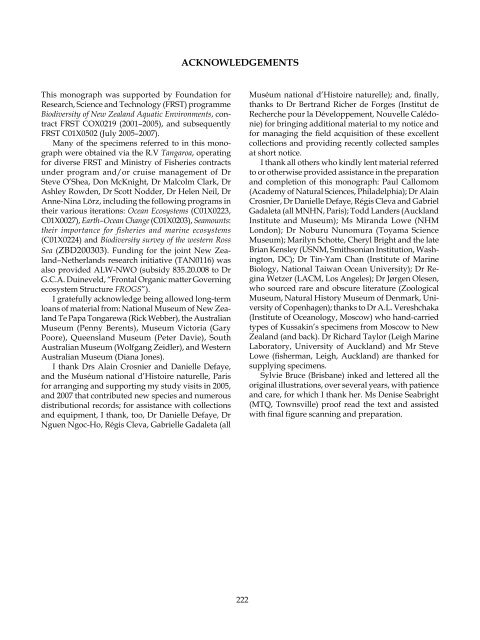The Marine Fauna of New Zealand: Isopoda, Aegidae (Crustacea)
The Marine Fauna of New Zealand: Isopoda, Aegidae (Crustacea)
The Marine Fauna of New Zealand: Isopoda, Aegidae (Crustacea)
Create successful ePaper yourself
Turn your PDF publications into a flip-book with our unique Google optimized e-Paper software.
This monograph was supported by Foundation for<br />
Research, Science and Technology (FRST) programme<br />
Biodiversity <strong>of</strong> <strong>New</strong> <strong>Zealand</strong> Aquatic Environments, contract<br />
FRST COx02 9 (200 –2005), and subsequently<br />
FRST C0 x0502 (July 2005–2007).<br />
Many <strong>of</strong> the specimens referred to in this monograph<br />
were obtained via the R.V Tangaroa, operating<br />
for diverse FRST and Ministry <strong>of</strong> Fisheries contracts<br />
under program and/or cruise management <strong>of</strong> Dr<br />
Steve O’Shea, Don McKnight, Dr Malcolm Clark, Dr<br />
Ashley Rowden, Dr Scott Nodder, Dr Helen Neil, Dr<br />
Anne-Nina Lörz, including the following programs in<br />
their various iterations: Ocean Ecosystems (C0 x0223,<br />
C0 x0027), Earth–Ocean Change (C0 x0203), Seamounts:<br />
their importance for fisheries and marine ecosystems<br />
(C0 x0224) and Biodiversity survey <strong>of</strong> the western Ross<br />
Sea (ZBD200303). Funding for the joint <strong>New</strong> <strong>Zealand</strong>–Netherlands<br />
research initiative (TAN0 6) was<br />
also provided ALW-NWO (subsidy 835.20.008 to Dr<br />
G.C.A. Duineveld, “Frontal Organic matter Governing<br />
ecosystem Structure FROGS”).<br />
I gratefully acknowledge being allowed long-term<br />
loans <strong>of</strong> material from: National Museum <strong>of</strong> <strong>New</strong> <strong>Zealand</strong><br />
Te Papa Tongarewa (Rick Webber), the Australian<br />
Museum (Penny Berents), Museum Victoria (Gary<br />
Poore), Queensland Museum (Peter Davie), South<br />
Australian Museum (Wolfgang Zeidler), and Western<br />
Australian Museum (Diana Jones).<br />
I thank Drs Alain Crosnier and Danielle Defaye,<br />
and the Muséum national d’Histoire naturelle, Paris<br />
for arranging and supporting my study visits in 2005,<br />
and 2007 that contributed new species and numerous<br />
distributional records; for assistance with collections<br />
and equipment, I thank, too, Dr Danielle Defaye, Dr<br />
Nguen Ngoc-Ho, Régis Cleva, Gabrielle Gadaleta (all<br />
AcKNOwlEdgEmENts<br />
222<br />
Muséum national d’Histoire naturelle); and, finally,<br />
thanks to Dr Bertrand Richer de Forges (Institut de<br />
Recherche pour la Développement, Nouvelle Calédonie)<br />
for bringing additional material to my notice and<br />
for managing the field acquisition <strong>of</strong> these excellent<br />
collections and providing recently collected samples<br />
at short notice.<br />
I thank all others who kindly lent material referred<br />
to or otherwise provided assistance in the preparation<br />
and completion <strong>of</strong> this monograph: Paul Callomom<br />
(Academy <strong>of</strong> Natural Sciences, Philadelphia); Dr Alain<br />
Crosnier, Dr Danielle Defaye, Régis Cleva and Gabriel<br />
Gadaleta (all MNHN, Paris); Todd Landers (Auckland<br />
Institute and Museum); Ms Miranda Lowe (NHM<br />
London); Dr Noburu Nunomura (Toyama Science<br />
Museum); Marilyn Schotte, Cheryl Bright and the late<br />
Brian Kensley (USNM, Smithsonian Institution, Washington,<br />
DC); Dr Tin-yam Chan (Institute <strong>of</strong> <strong>Marine</strong><br />
Biology, National Taiwan Ocean University); Dr Regina<br />
Wetzer (LACM, Los Angeles); Dr Jørgen Olesen,<br />
who sourced rare and obscure literature (Zoological<br />
Museum, Natural History Museum <strong>of</strong> Denmark, University<br />
<strong>of</strong> Copenhagen); thanks to Dr A.L. Vereshchaka<br />
(Institute <strong>of</strong> Oceanology, Moscow) who hand-carried<br />
types <strong>of</strong> Kussakin’s specimens from Moscow to <strong>New</strong><br />
<strong>Zealand</strong> (and back). Dr Richard Taylor (Leigh <strong>Marine</strong><br />
Laboratory, University <strong>of</strong> Auckland) and Mr Steve<br />
Lowe (fisherman, Leigh, Auckland) are thanked for<br />
supplying specimens.<br />
Sylvie Bruce (Brisbane) inked and lettered all the<br />
original illustrations, over several years, with patience<br />
and care, for which I thank her. Ms Denise Seabright<br />
(MTQ, Townsville) pro<strong>of</strong> read the text and assisted<br />
with final figure scanning and preparation.

















